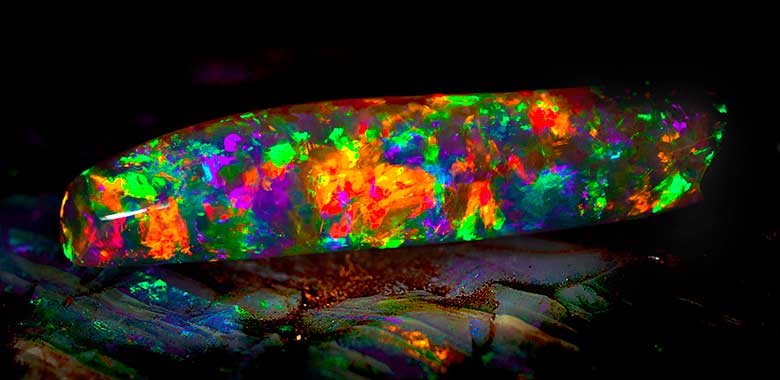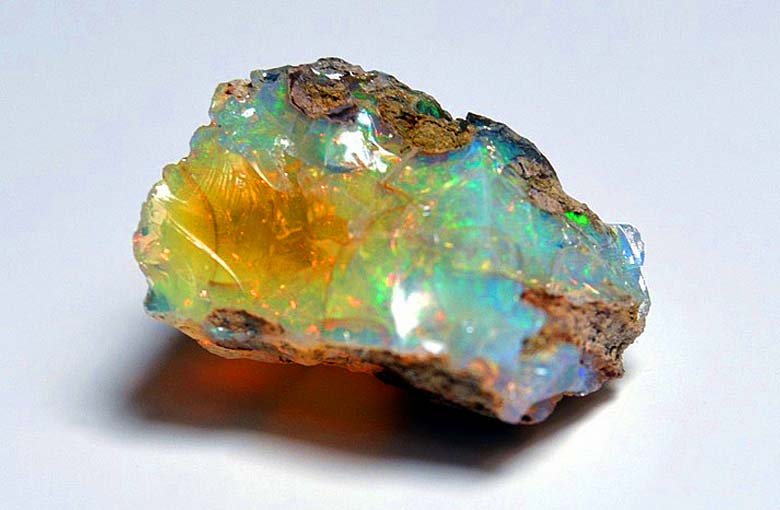Interesting Facts About Opal
Opal is one of the most beautiful and precious gemstones in the world. Here are 25 Interesting Facts About Opals You Probably Didn’t Know. The play of color they display makes them a favorite amongst collectors, geologists, and jewelers. Historically the brilliant colors of precious opal have made it a favorite amongst royalty. To learn more about this beautiful stone, read these 25 interesting facts about opal.
1. Origins of the opal
While the exact date of discovery for opals is still disputed, the earliest artifacts containing opals come from before 4000 BC. The Romans called opals, opalus, which translates to the precious stone. A truly deserving name for this magnificent gem! The ancient Greeks believed that opals were formed from the tears of joy wept by Zeus when he defeated the titans and that the opal bestowed prophetic powers. others believe it’s derived from the Sanskrit word “úpala” meaning precious stone.
Some of the nicknames given to opals throughout their illustrious history include; Pandora, Light of the World, and the Empress of Jewels.
2. Opal can be precious or common
The two varieties of opal most often seen are common and precious. The difference between the two comes from the optical effect they produce. While both common and precious opals are opalescent, they are so to different degrees. Precious opal displays a play-of-color not present in other opals. The precious opal’s opalescence is a result of spaces between the silica spheres in the internal structure of the stone. These spaces allow for light to pass through and create the vivid, colorful refractions within the opal we associate with it. Common opal on the other hand is much simpler and displays a hazy-milky sheen.
3. There’s more than one color of the opal
There are many color variations of both precious and common opal. Though precious opals exhibit a variety of colors such as yellows, greens, blues, and reds the “color” of a precious opal refers to the background color of the stone. This can be almost any color, however most common are white, green, or translucent.
Common opals can also come in many different colors such as purple, pink, blue, and green. They are often mistaken for varieties of quartz due to their more simple appearance.
4. Opal is classed as a mineral, not a crystal
Unlike other gems, opals don’t have a crystalline structure. Instead, when looked at under a 30,000X microscope, opals are made up of billions of silica spheres in a uniform grid and are considered a mineraloid, similar to obsidian, amber, and pearl. A mineraloid is a naturally occurring substance that does not display crystallinity, meaning the atoms of the mineral are not arranged at regular intervals as they are in crystals.
5. The National Gemstone of Australia is the Opal, The land of Opal mining
Opal is the national gemstone of Australia. where opals are believed to have first formed. Australia mines over 95% of the world’s precious opals for use in jewelry. The amount of opal in Australia makes it the natural choice for the country’s national gemstone. Most are white opals from the Coober Pedy area of South Australia. Indigenous Australian myths often link the creation of opals with rainbows, making the stone known as the rainbow stone. In one myth, an ancestral being came to earth on a rainbow and when the rainbow touched the ground all pebbles and rocks in the vicinity began sparkling and turned to opal.
Some of the lesser countries that also mine for opal are Brazil, Mexico, Peru, Nicaragua, and Ethiopia.
6. Opal can be synthesized
As with most gemstones, opals can now be made in a laboratory. It was first synthesized in 1974 by Pierre Gilson. Since the technology was pioneered, synthesizing opals has much improved, and modern lab-created opals do not have the lizard skin patterning earlier attempts did. Modern synthetic opals have non-directional patterns making them appear much more similar to genuine opals. Lab-created opals, however, can still be distinguished by the lack of inclusions in the stone.
7. In the Middle, Ages opal was considered good luck
In the Middle Ages, opal stones were seen as extremely valuable and as bringers of good luck. This changed after 1829 when Sir Walter Scott published his novel Anne of Geierstein. In his story, one of the characters wears an opal talisman with supernatural powers. A drop of holy water on the opal however turns it into a common stone and the character wearing it dies soon after. Since the publication of the book, opals began to be associated with death, evil and bad luck. This took root in the collective mindset and became a superstition of its own. For years to come, even up until the early 1900s, opals were avoided. During the Art Deco era, opals came back in favor due to their glamorous nature.
8. Black opal is the rarest variation of the stone
Black opals, nicknamed “The Mother of all Gemstones” by Shakespeare, are one of the rarest gemstones. So far black gemstones have only been discovered in Australia, specifically around the town of Lightning Ridge. This makes black opals highly sought after. Their darker color allows for the diffractions of light to truly shine through and take center stage.
9. Opal is the birthstone for the month of October
Here are a couple of opal facts that you might want to learn for when the time comes to purchase the perfect gift.
Opal is believed to be able to bring good luck, health, and fortune to its wearer. The stone is associated with purity and emotions as many believe it’s able to intensify and reflect the mood of the wearer. Opal is seen as able to encourage creativity as it promotes interest in the arts. In new-age circles, it’s seen as a healing stone that can treat fevers and infections and can work to purify the blood and regulate insulin.
Opal is the official birthstone for anyone born in October. Also, in traditional gift-giving, opal is the suggested gift for a 14th wedding anniversary.
10. The Virgin Rainbow is the world’s most expensive and famous opal

The world’s most expensive opal, the Virgin Rainbow, is valued at over 1,000,000 dollars. It was discovered in Australia in 2003 by John Dunstan. The opal was formed and discovered in the skeleton of a Belemnite, an ancient ancestor of the modern-day cuttlefish. The Virgin Rainbow opal is a sight to behold! The range of colors within this opal is infinite and people get lost in its beauty unable to take their eyes off of the ever-changing play of light. The Virgin Rainbow is currently owned and displayed by the South Australian Museum.
11. Opal on Mars
Can you believe it? This is one of the coolest facts about opals hands down! In July 2015 the NASA Reconnaissance Orbiter discovered opal deposits on the surface of Mars. It is one of the few gemstones ever discovered outside of our planet. (the other gemstone being Peridot’s found from outer space).
12. The spirituality of the opal
Opals are good luck stones that can protect us from nightmares and bad spirits. Opals are also said to have the ability to quiet thoughts, bring on visions, and foster connection with the spirit world. So you wanna talk to a ghost? You need some opals in your life!
Now opal is even considered a talisman and a symbol of social status in some countries.
13. Opals are good luck!
Even as far back as the Romans, opals have been considered lucky. The Romans thought that since opals were made up of all the colors of the different gemstones, the good qualities of each were encompassed in the opal’s rainbow.
14. What am I going to pay?
An opal’s price depends on a few criteria. The type of opal is the first thing to consider, followed by the vibrancy and deepness of the color, and the diversity of color.
For the famous and rare black opal, you’re looking at $100 to $1,500 per carat. Start saving now!
15. The greatest opal miner
Just call him the opal hunter! Charlie Dunstan has discovered some of the most famous opals of all time.
In 1938 he unearthed the Aurora Australis opal, the most valuable black opal valued at over $1 million. He also mined the Andamooka opal that was gifted to Queen Elizabeth II in 1954.
16. More than it seems at first glance
The play of color you see in Opal is due to millions of tiny silica Spheres of different sizes. These spheres refract light and cause the beautiful spectral colors you see in an opal. The spheres have to be just the right size and of a uniform nature to create enough color for our eyes to see.
17. What happened 30 million years ago?
Opal was first formed by deposits of silica that solidified between rocks 20 to 30 million years ago. How long exactly does it take opal to form?
Not too long, just 5 million years! This was one of the opal facts that blew our minds!
18. Let it rain!
Believe it or not, opal formation can be linked back to a single raindrop. Most experts believe that rain washed silica into the cracks and canyons of what is now Australia.
When the rainwater evaporated, the silica was left behind to start the 5 million-year process of hardening into opal!
19. The Queen of precious stones
The ancient Romans considered it a symbol of hope and good fortune. A roman scholar in 75AD summed up our beautiful opal by saying: Some opals carry such a play within them that they equal the deepest and richest colors of painters. Others said – they simulate burning fire and even bright flames from burning oil. This kaleidoscopic gem included the red color of Ruby, green of the Emerald, yellow of the Topaz, blue of the Sapphire, and purple of the Amethyst, which is why opal is commonly called the queen of precious stones.
20. Opals In Aboriginal History
Australian native Aborigines tell us that opal is our creator’s footprint, that touched the Earth at the base of a rainbow to bring harmony.
21. The opal capital of the world
Coober Pedy, Australia is famous for opal mining. In fact, most people live in underground houses to avoid the sweltering heat.
How did the town get such an odd name? The indigenous phrase kupa-piti, means white man in a hole.
22. Royal opals
Opal was the favorite gemstone of Queen Victoria. She had Sapphires, Rubies, and Diamonds from all over the British Empire, but she fell in love with the intoxicating colors of opals.
23. Water softener
While gemstones like diamonds are so hard they can’t even be scratched, the opal is quite soft in comparison. Opals are 6 on the MOHS scale of hardness compared to a diamond’s 10.
The reason? There is still unevaporated water in an opal. A typical opal can have between 3% and 20% water content.
24. Cracks in the foundation
Because of the high water content of opal, opal is the most delicate of all gemstones. In fact, the water in an opal never stops evaporating, leading to opals sometimes cracking over time. To us, the fragility of opal makes it even more precious!
25. Oh, the many ways to describe an opal
Known for its multitude of ever-changing colors it isn’t surprising that describing the opal with words is an almost impossible task.
However, some have tried, with opals being compared to erupting volcanoes, nebulous galaxies, and exploding fireworks. But really, you gotta see it to believe it!
The next time someone asks you why your Opal is so special you can rattle off a few of these amazing facts about Opals.
